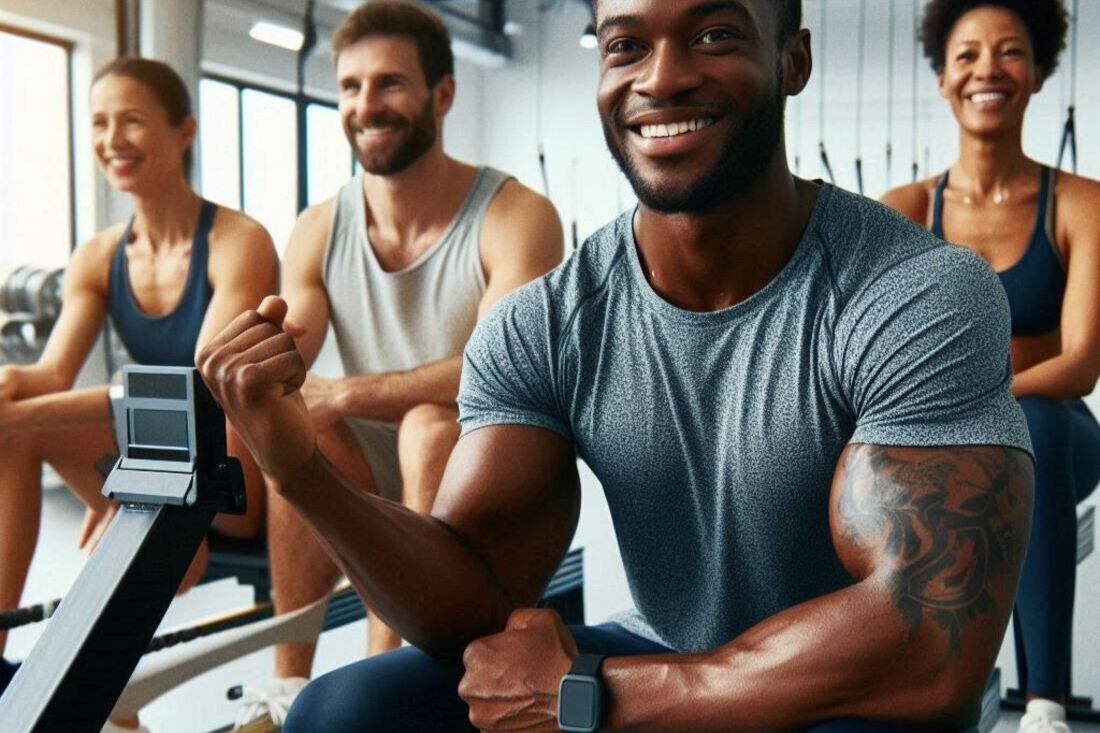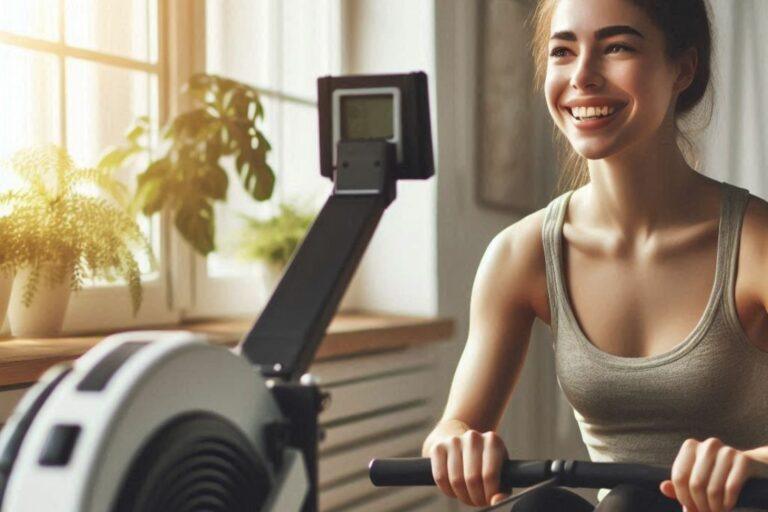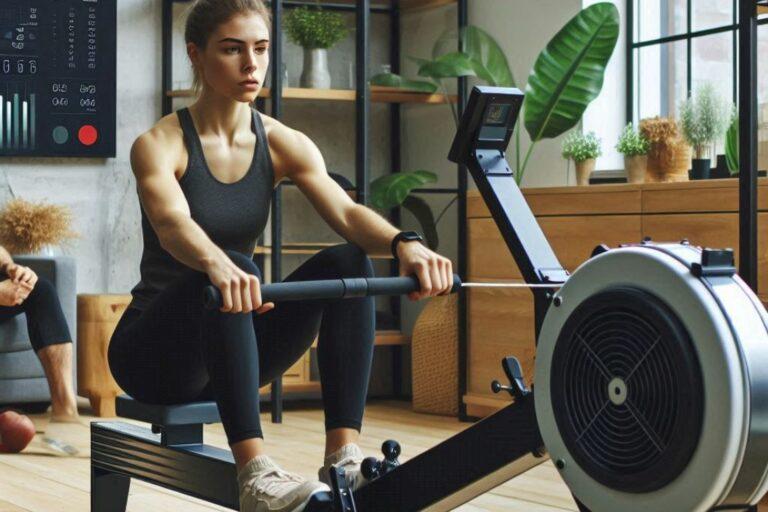Have you ever watched elite rowers and wondered how they achieve such effortless power and grace?
Mastering the perfect rowing stroke is the key to unlocking the full potential of your rowing machine and enjoying a more effective, injury-free workout.

Many beginners struggle with proper rowing technique, leading to suboptimal results and even discomfort.
This guide will break down the rowing stroke into easy-to-understand steps, helping you develop the skills to row efficiently and confidently.
Let’s dive in and discover the secrets to mastering the perfect rowing stroke.
The Phases of the Rowing Stroke
Mastering the rowing stroke is essential for maximizing efficiency and preventing injuries. Let’s break down the stroke into its four key phases:
Catch Phase
The catch phase is the starting position of the rowing stroke. Here’s what it involves:
- Body position: Lean slightly forward with a straight back.
- Leg angle: Knees bent, shins vertical.
- Arm placement: Arms extended, hands gripping the handle.
This position prepares your body for the powerful drive phase.
Drive Phase
The drive phase is where the power is generated. Here’s how to execute it effectively:
- Leg drive: Initiate the stroke by extending your legs forcefully.
- Body angle: Gradually lean back as your legs extend.
- Arm pull: Once your legs are fully extended, begin pulling the handle towards your chest.
Finish Phase
The finish position marks the end of the power-generating phase.
- Full extension: Legs fully extended, body leaned back.
- Core engagement: Maintain a strong core to support the body.
- Arm position: Arms pulled to the chest, elbows close to the body.
Recovery Phase
The recovery phase is the transition back to the catch position.
- Arm recovery: Extend your arms first, allowing the handle to move forward.
- Body recovery: Return your body to a forward lean, hinging at the hips.
- Leg recovery: Slide the seat forward to the catch position.
This video lays the groundwork for proper rowing form. It demonstrates the ideal positioning for your head, wrists, body, back, and legs throughout the rowing stroke.
You’ll also learn about the different phases of a rowing motion.
Key Takeaways: The Phases of the Rowing Stroke
- Mastering the catch phase: Proper body positioning is crucial for initiating the stroke efficiently.
- Powering through the drive phase: Engage the legs, core, and arms in a coordinated movement.
- Completing the finish: Maintain a strong core and full extension for maximum power transfer.
- Smooth recovery: Return to the catch position with controlled movements.
By understanding and practicing these key elements, you’ll develop a fluid and effective rowing stroke.
Common Mistakes and Corrections
Even the most experienced rowers can fall victim to common technique errors.
By identifying and correcting these mistakes, you can significantly improve your rowing efficiency and prevent injuries.
Common Mistakes
- Hunching over: This can lead to back pain and reduced power output.
- Overusing arms: Relying too much on arm strength can hinder performance and cause fatigue.
- Bouncing on the seat: Excessive movement can disrupt your rhythm and reduce efficiency.
- Incorrect handle grip: A poor grip can affect your overall stroke and comfort.
Corrections
- Maintain a tall posture: Focus on engaging your core and keeping your back straight.
- Prioritize leg drive: Generate power primarily from your legs, using your arms for support.
- Smooth and controlled movements: Avoid jerky or abrupt motions.
- Experiment with different grips: Find a handle position that feels comfortable and allows for maximum power transfer.
We all make mistakes, and rowing is no exception! This video identifies some common form errors that can hinder your performance or lead to injury.
Learn how to avoid bad habits related to wrist, arm, head, shoulder, back, and leg positioning.
Key Takeaways: Common Mistakes and Corrections
- Identify and correct common errors: Recognizing and addressing technique flaws is crucial for improvement.
- Prioritize leg drive and core engagement: Shifting focus from arms to lower body enhances efficiency.
- Maintain proper posture: Avoid hunching to prevent back pain and optimize performance.
- Experiment with grip and handle position: Find the most comfortable and effective setup.
By addressing these common mistakes and implementing the corrections, you’ll be well on your way to mastering the perfect rowing stroke.
Building Strength and Endurance
To truly maximize the benefits of rowing, it’s essential to focus on both strength and endurance.
Let’s explore how to build these components into your routine.
Incorporating Strength Training
While rowing engages multiple muscle groups, targeted strength training can enhance your performance.
Consider incorporating exercises like:
- Upper body: Pull-ups, rows, and push-ups
- Lower body: Squats, lunges, and calf raises
- Core: Planks, crunches, and Russian twists
Endurance Building
To increase your rowing endurance, focus on sustained efforts and gradually increasing workout duration.
Here are some tips:
- Steady-state rowing: Maintain a consistent pace for extended periods.
- Interval training: Alternate between high-intensity bursts and recovery periods.
- Cross-training: Incorporate other cardio activities like running or swimming.
By combining strength training and endurance exercises, you’ll create a well-rounded rowing routine that yields optimal results.
Creating a Beginner-Friendly Workout Routine
Consistency is key to building strength and endurance. Let’s create a basic workout plan to get you started.
Sample Workout Plan
- Warm-up: 5 minutes of light rowing at a comfortable pace
- Main set: 20-30 minutes of continuous rowing, focusing on maintaining proper form
- Cool-down: 5 minutes of easy rowing and static stretches
Note: This is a starting point. As you build endurance, you can gradually increase the duration of your workouts.
Tips for Progression
- Gradual increase: Add 5 minutes to your workout every week to improve endurance.
- Vary your pace: Incorporate short bursts of higher intensity to challenge yourself.
- Listen to your body: Rest when needed and avoid overexertion.
Incorporating Variety
To prevent boredom and plateaus, consider these options:
- Online workouts: Follow guided routines for motivation.
- Interval training: Alternate between high and low intensity for added challenge.
- Cross-training: Combine rowing with other forms of exercise.
By following these guidelines, you can create a well-rounded workout routine that fits your fitness level and goals.
Overcoming Common Challenges
Starting a new workout routine can be challenging. Here are some common obstacles you might face and how to overcome them:
Dealing with Soreness
Muscle soreness is common when starting a new exercise. To alleviate discomfort:
- Warm-up and cool-down: Proper preparation can help reduce muscle soreness.
- Active recovery: Light activities like walking or swimming can aid recovery.
- Listen to your body: Rest when needed and avoid overexertion.
Staying Motivated
Maintaining motivation can be difficult. Here are some tips:
- Set realistic goals: Break down your fitness goals into smaller, achievable steps.
- Find a workout buddy: Having a partner can make workouts more enjoyable and help you stay accountable.
- Reward yourself: Celebrate milestones and achievements to stay motivated.
Tracking Progress
Monitoring your progress helps you stay motivated and identify areas for improvement.
Consider using a workout journal or fitness app to track your workouts, distance, and time.
By addressing these common challenges, you can increase your chances of sticking to your rowing routine and achieving your fitness goals.
FAQs: Common Rowing Technique Questions
- How can I improve my rowing speed?
- Focus on increasing stroke rate while maintaining proper form. Incorporate high-intensity intervals into your workouts to challenge yourself.
- What muscles does rowing target?
- Rowing is a full-body workout, primarily engaging the legs, core, back, and arms.
- How often should I row to see results?
- Aim for 3-4 sessions per week to start. Consistency is key to building strength and endurance.
- Can I use a rowing machine to lose weight?
- Absolutely! Rowing is an effective calorie-burning exercise that can contribute to weight loss when combined with a balanced diet.
Testimonials

“I struggled with gym intimidation, but rowing at home has been a game-changer. This guide helped me break down the technique into easy-to-follow steps. I feel more confident with each session.” – Sarah K.
“I was unsure about investing in a rowing machine, but this guide convinced me to take the plunge. I’m so glad I did! My posture has improved dramatically, and I’m enjoying the workouts.” – David M.
“As a busy mom, finding time to exercise is challenging. Rowing has become my go-to workout. This guide helped me overcome my initial hesitation and start seeing results.” – Emily P.
Conclusion
Embarking on a rowing journey as a beginner can be exciting yet challenging.
By understanding the fundamentals of rowing technique, creating a structured workout routine, and overcoming common obstacles, you’ll be well on your way to reaping the benefits of this fantastic exercise.
Remember, consistency is key.
Start with achievable goals and gradually increase the intensity and duration of your workouts.
Listen to your body, and don’t be afraid to experiment with different rowing techniques to find what works best for you.
With dedication and perseverance, you’ll discover the joy and satisfaction of rowing while improving your overall fitness and well-being.
Happy rowing!
Ready to take your rowing to the next level? Explore our additional resources for advanced techniques, workout plans, and equipment recommendations.
Reference
Improve your Rowing Technique by Concept2



